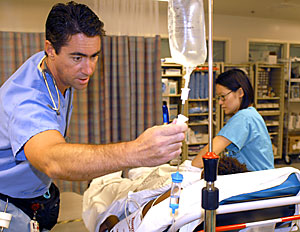 |
|
CLAIRE C. LAURENCE/Arizona Daily Wildcat
|
Registered nurse Paul Bosseler checks IV flow while Dr. Amy Zheng runs a series of palpitations on a patient admitted to the UMC trauma center with complaints of severe chest pain. UMC is the only trauma center in the city of Tucson, a title it used to share with TMC.
|
|
|
By April Lacey
Arizona Daily Wildcat
Wednesday, September 29, 2004
Print this
UMC rises to challenge of being Tucson's only trauma center
The staff at the University Medical Center stepped up to the challenge of becoming the only trauma center in Tucson last year, and officials say employees are more skilled because of it.
Since the closure of Tucson Medical Center's trauma center on July 1, 2003, the UMC trauma center has had a 48 percent increase in the number of trauma patients, said Daniel Judkins, trauma center coordinator.
Judkins said since UMC became the only trauma center in Tucson, its staff has become more skilled because they have been forced to handle more cases.
"The more they do it, the better they get," Judkins said.
To adjust to the higher number of patients, UMC has increased the number of emergency department staff, including nurses and registration clerks, said Kevin Craven, the director of emergency and trauma services.
In the past year, UMC has added about 10 full-time equivalency hours to its nursing staff, Craven said. That means UMC has hired enough nurses to cover 400 extra hours per week.
UMC has also added more critical care beds to its center, Judkins said.
When the decision was made to close TMC's trauma center, it created controversy because some doubted UMC could handle all the trauma patients previously allocated to two centers.
TMC announced in December 2002 it would close its trauma center unless it could obtain at least $3.3 million from the state.
Because the state was unable to fund two trauma centers, TMC's trauma center closed.
"The decision to close TMC was based on economics. It costs the community less money to support only one center with the 24-hour staff and resources it takes to run a trauma center," Judkins said.
Due to the higher number of trauma patients, UMC sometimes sends less severe cases to other hospitals in Tucson, Judkins said.
A patient is considered a trauma case when he or she has been critically hurt or has been in an accident in which critical injuries are typical.
"All the hospitals in Tucson agreed (that) on those few occasional times when case volume gets too high, (UMC would) redirect the least injured patients to other hospitals," Judkins said.
Nearly 11 percent of trauma cases since July 1, 2003, have been redirected to other hospitals such as St. Mary's, Northwest Hospital and TMC, Judkins said.
"From July of 2003 to June of 2004, 529 out of 4,436 cases were directed to other hospitals," Judkins said.
Judkins says although patients have to be redirected, it does not pose a problem to their health. If a patient is a less severe case, it is not a health risk to take the time to send him or her to a different hospital for assistance, Judkins said.
If a redirected patient has an injury too serious for another hospital to treat, the patient is sent back to UMC for care.
"That gives us enough breathing room. That's how we've done it and it works," Judkins said.
Since becoming the sole trauma center in Tucson, UMC has had no deaths or serious consequences resulting from the fact that they now stand alone.
UMC currently serves an area of 1.2 million people, a population Judkins says is "workable."
"A population of 1 million calls for one trauma center," Judkins said.
UMC earned the 2004-2005 consumer choice award by the National Research Corporation, a national health-care performance measurement firm.
